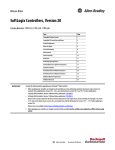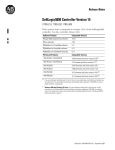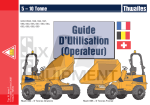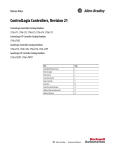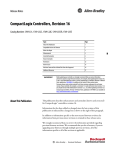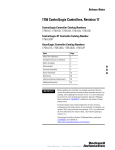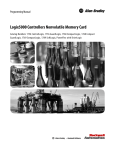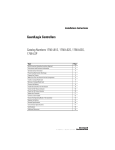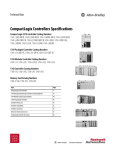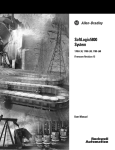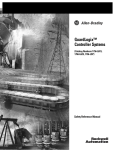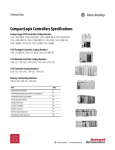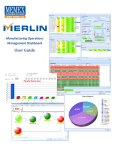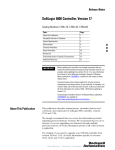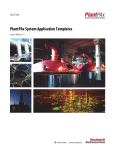Download SoftLogix Controllers, Version 21
Transcript
Release Notes SoftLogix Controllers, Version 21 Catalog Numbers 1789-L10, 1789-L30, 1789-L60 IMPORTANT Topic Page Compatible Software Versions 3 System Requirements 4 Before You Begin 5 Enhancements 5 Corrected Anomalies 5 Known Anomalies 7 Restrictions 8 Performing Typed Operations 10 Functionality Issues in Specific Circumstances 11 Additional Memory Requirements 12 Additional Resources 21 Consider the following before upgrading your SoftLogix™ 5800 controller: • Before updating your controller, we strongly recommend that you review information pertinent to previous major versions. For example, when updating from version 18.x…20.x, view information for versions 18.15 and 19.11 in these publications: - SoftLogix 5800 Controllers, Version 18 Release Notes, publication 1789-RN018 - SoftLogix 5800 Controllers, Version 19 Release Notes, publication 1789-RN019 - SoftLogix 5800 Controllers, Version 20 Release Notes, publication 1789-RN519 Release notes contain material for all minor versions subsequent to each major version. If your controller, for example, is at version 18.11, and not the latest version, such as 20.x, you should view all of the information for version 18.11…19.11 before updating to version 20.x. Release notes are available at http://www.rockwellautomation.com/literature. • After upgrading your controller, we strongly recommend that you retest and/or validate your application offline before going online. 2 SoftLogix Controllers, Version 21 About This Publication This publication describes SoftLogix 5800 controllers, version 21.03.00. Information that has been added or changed since the last revision of this publication is indicated by a change bar as shown to the side of this paragraph. In addition to information specific to the most recent software version, the information from previous minor versions is retained in these release notes. We strongly recommend that you review the information provided regarding previous software versions. We recommend that you do so because, if you are upgrading your software through multiple previous versions, all of the information specific to all of the versions is applicable. About Publication 1789-RN210B-EN-P This revision of the SoftLogix Controllers Release Notes, publication 1789-RN210B, provides updated information specific to version 21.03.00. Table 1 - Controller Versions Identified in Publication 1789-RN210B Cat. No. Version 1789-L10 21.03.00 1789-L30 1789-L60 About Publication 1789-RN210A-EN-P This publication describes SoftLogix 5800 controllers, version 21.00.00. Table 2 - Controller Versions Identified in Publication 1789-RN210A Cat. No. Version 1789-L10 21.00.00 1789-L30 1789-L60 Rockwell Automation Publication 1789-RN210B-EN-P - April 2014 SoftLogix Controllers, Version 21 3 Compatible Software Versions To use version 21.03.00, these minimum software versions are required. Table 3 - Compatible Software Versions Software Required Software Version, Min Compare Tool 3.40.00 ControlFLASH™ 12.00.00 FactoryTalk® AssetCentre 4.10.00 (CPR9, SR5.1) FactoryTalk Services Platform 2.51.00 (CPR9, SR5.1) FactoryTalk Activation 3.51.00 (CPR9, SR5.1) RSLinx® Classic 3.51.01 (CPR9, SR5.1) RSLinx Enterprise 5.51.00 (CPR9, SR5.1) Studio 5000 Logix Designer™ 21.03.00 (CPR9, SR5.1) IMPORTANT ControlNet and DeviceNet networks are supported in SoftLogix controllers, version 20 and earlier. The Studio 5000® Engineering and Design Environment combines engineering and design elements into a common environment. The first element in the Studio 5000 environment is the Logix Designer application. The Logix Designer application is the rebranding of RSLogix™ 5000 software and will continue to be the product to program Logix5000™ controllers for discrete, process, batch, motion, safety, and drive-based solutions. The Studio 5000 environment is the foundation for the future of Rockwell Automation® engineering design tools and capabilities. It is the one place for design engineers to develop all of the elements of their control system. Rockwell Automation Publication 1789-RN210B-EN-P - April 2014 4 SoftLogix Controllers, Version 21 System Requirements This table identifies system requirements for the SoftLogix 5800 controller. IMPORTANT Use the computer that is running the SoftLogix controller like an industrial controller, not a personal computer. The SoftLogix 5800 controller executes real-time operations. If you use other programs or applications on the computer when the SoftLogix 5800 controller is executing real-time operations, those operations can be disrupted. IMPORTANT SoftLogix controllers and software do not support Integrated Motion on the EtherNet/IP network. The ControlNet and DeviceNet networks are supported in SoftLogix controllers, version 20 and earlier. When using a SoftLogix controller on a Microsoft Windows 7 operating system, an Ethernet network is the only communication network supported. No other communication modules are supported or should be used. Rockwell Automation PCI-based cards are not supported when using the Microsoft Windows 7 operating system. If you need information on Compatible PCI-based cards for previous versions, see SoftLogix 5800 Controllers, Version 20 Release Notes, publication 1789-RN519. For more information, see Knowledgebase document KB 509008. Table 4 - System Requirements for Version 21 Controllers Category Description Personal computer IBM-compatible Pentium 4 1.6 GHz or later(1) Other requirements include the following: • FactoryTalk Activation Manager if you are currently using Factory Activation software. • A hard disk that supports bus mastering. • The need for bus-mastering drivers for the personal computer’s chip set; for Intel motherboards, this software is called Application Accelerator. • Applications that are resource-intensive, including applications that use sequential, motion, and other local applications running on the computer, may require a dual CPU to achieve performance requirements. • The Logix Designer application, version 21, is not required. Operating systems • Microsoft Windows 7 Home Premium Service Pack 1 • Windows 7 Professional Service Pack 1 • Microsoft Windows Server 2008 R2 Standard Edition Service Pack 1 IMPORTANT: When a SoftLogix controller is installed, the following modules are available in the Chassis Monitor: • SoftLogix controller • Soft ENBT • Input/output simulator module IMPORTANT: Motion, ControlNet, and DeviceNet modules are currently not supported in SoftLogix controllers, version 21. RAM 1 GB, min Hard disk space 64 MB of free hard disk space per controller instance (or more based on application requirements) Network requirements Supports EtherNet/IP and Ethernet port of the personal computer. Third-party networks are supported through the Rockwell Automation Encompass™ program. Video requirements 16-color VGA graphics adapter 640 x 480, or later resolution (256-color, 800 x 600 min, for optimal resolution) (1) The SoftLogix 5800 controller has been tested and qualified only on genuine Intel processors. Rockwell Automation Publication 1789-RN210B-EN-P - April 2014 SoftLogix Controllers, Version 21 5 Before You Begin Before you upgrade your controller, consider how close it is to the limits of memory. This version may require more memory than previous versions. To see what components of your current project require more memory, see Additional Memory Requirements on page 12. IMPORTANT Rockwell Automation does not assume responsibility or liability (to include intellectual property liability) for actual use of the external routines featured in a control system application. The Logix Designer application lets you estimate the memory requirements of the controller offline. This enhancement is available when you use controller version 21.00.00 and later. Enhancements Table 5 - Enhancements with Version 21 Controllers Cat. No. Description 1789-L10, 1789-L30, 1789-L60 In shipping versions of the Logix Designer application, including versions 20, 19, 18, 17 and 16, changes were made to pre-scan execution of Add-On Instructions. In these versions of the Logix Designer application, when an Array Index is out of bounds during pre-scan execution of the Add-On Instruction, the instruction is partially executed and the remainder of the instruction execution is skipped during pre-scan. Corrected Anomalies These anomalies have been corrected with these controller versions. Table 6 - Corrected Anomalies with Version 21 Controllers Cat. No. Description 1789-L10, 1789-L30, 1789-L60 CORRECTED: In SFCs, when using time-limited actions in steps, if the program stays on a given step for greater than 24 days (2**32 ms) the timers accumulate (ACC) will roll over and the action body starts to execute again. The time-limited action initializes its timer when it starts (step is first scanned). On subsequent scans, it compares the timers PRE and ACC value. If ACC<PRE, the action body will execute. If ACC >=PRE, it is not executed. When the roll over occurs, the ACC,PRE and the action body will again execute when it should not. Lgx00124689, Lgx00124697 CORRECTED: The controller only supports three active reconfigure messages at a time. If more than three are triggered at a time, they will complete (DN bit will go high), but not all the modules will be reconfigured. For example, if you send five reconfiguration messages at the same time, three reconfigure messages will truly complete (DN bit will go high), and the I/O modules will be reconfigured. The other two reconfigure messages will indicate complete (DN bit will go high), but the I/O modules will not be reconfigured. In this case, the last two should have errored (ER bit), but do not. Lgx00125204, Lgx00124996 Rockwell Automation Publication 1789-RN210B-EN-P - April 2014 6 SoftLogix Controllers, Version 21 Table 6 - Corrected Anomalies with Version 21 Controllers (continued) Cat. No. Description 1789-L10, 1789-L30, 1789-L60 CORRECTED: Log On to FactoryTalk Dialog Box Displays When Launching RSLogix 5000 Software When launching RSLogix 5000 software, the Log On to FactoryTalk dialog box may be displayed. This dialog box may be seen when you do not have Administrator privileges on the personal computer and the current user does not exist in the FactoryTalk directory. If this dialog box is cancelled, the RSLogix 5000 software will not be launched. When the dialog box is displayed, entering the credentials for a user that has Administrator privileges on the personal computer will then allow RSLogix 5000 software to be launched. To avoid seeing this dialog box, you can add the current user or user group to the FactoryTalk directory. Follow these steps to add a user or user group to the FactoryTalk directory. 1. Launch the FactoryTalk Administration Console (available from the Start menu). 2. Select the Network directory when prompted. (You may need to provide credentials for a user with Administrator privileges to continue.) 3. To allow access for a particular user, navigate to Network\System\Users and Groups\Users, right-click the Users folder and choose New>Windows Linked User. 4. Click Add and provide the domain\logon name for the desired user. (You can click Check Names to verify that the name was found.) 5. To allow access for all authenticated users, navigate to Network\System\Users and Groups\User Groups, right-click the User Groups folder and choose New>Windows Linked User Group. 6. Click Add and type the name of the user group, Authenticated Users. The Log On to FactoryTalk dialog box may also display when using Remote Desktop to connect to the personal computer running RSLogix 5000 software. This is due to FactoryTalk Security not recognizing the computer name. To enable access through Remote Desktop for a specific computer, you should add the name of the computer initiating the Remote Desktop connection to the Network\System\Computers and Groups\Computers folder in the FactoryTalk Administration Console. To allow all computers to connect, follow these steps. 1. Open the FactoryTalk Administration Console and log in to the Network directory using your domain credentials. 2. Navigate to Network\System\Security Policy. In the Computer Policy Settings section, set Identify terminal server clients using the name of to Server Computer. IMPORTANT: If Use single sign-on is set to disable in FactoryTalk software, then the Log On to FactoryTalk dialog box will be displayed each time RSLogix 5000 software is launched and proper user credentials must be entered to continue. (By default, ‘Use single sign-on’ is set to enable.) Lgx00124955 CORRECTED: Micro830™ controllers will cause an error when opening the SoftLogix Chassis Monitor. To avoid this problem, keys were deleted in the registry after plugging in the Micro830 controller. HKEY_LOCAL_MACHINE\SOFTWARE\Rockwell Automation\VirtualBackplaneMonitor\Installed Modules\0001!000E!00XX 0001!000E!007B 0001!000E!007C 0001!000E!007D 0001!000E!007E 0001!000E!007F 0001!000E!0080 0001!000E!0081 0001!000E!0082 0001!000E!0087 0001!000E!0088 0001!000E!0089 0001!000E!008A Lgx00125634 CORRECTED: Changes made to the Buffer Timeout value for FactoryTalk Alarms and Events subscribers do not take effect until the existing buffer has been deleted. The FactoryTalk Alarms and Events alarm buffer (stored in Logix controller memory) is designed to persist through power cycles. If you change the Buffer Timeout value (via the Communication Setup dialog box in FactoryTalk View SE software), the controller does not use the new timeout value until the existing buffer is deleted and then recreated. To force recreation of this buffer, do one of the following: • Redownload the project to the controller. • Disconnect the FactoryTalk Alarms and Events subscriber and leave it disconnected until the existing timeout expires. Lgx00069461 Rockwell Automation Publication 1789-RN210B-EN-P - April 2014 SoftLogix Controllers, Version 21 7 Known Anomalies These anomalies have been identified with version 21 controllers. Table 7 - Known Anomalies with Version 21 Controllers Cat. No. Description 1789-L10, 1789-L30, 1789-L60 No Arithmetic Overflow Minor fault is seen in the Softlogix software, but is seen in a hard controller if you are passing parameters to an Add-On Instruction and the source value exceeds the range of Add-On Instruction’s parameter. For example, if the Add-On Instruction input parameter type is SINT, and the source value passed to the Add-On Instruction is 99999 (9999 exceeds the range of SINT which is -128 to 127), in a hard controller, you will see overflow minor fault but will not in the Softlogix software. Lgx00118782, Lgx00127537 Repeated power cycling or resetting the ethernet switch that connects the Softlogix I/O module to the control system may cause the Softlogix ethernet connections not to be re-established. Resolving this condition requires removing the Softlogix ethernet module from the Chassis Monitor then re-insert the Softlogix Ethernet module once the power to the ethernet switch has been restored. Lgx00126929 When the MCR zone is disabled, all rungs inside the MCR zone are expected to be disabled. However, if LBL instruction is used in a rung inside the disabled MCR zone, the instructions after LBL in that rung will be enabled, which is incorrect. Lgx00136977 When using the Automatic Device Configuration (ADC) feature, the Logix controller ‘owns’ the configuration in the drive. Do not use the HIM or other external tools, such as DriveExplorer, to change drive parameters. Doing so may cause a sequence of events to occur that results in the connection between the controller and the drive to be dropped, and causes the controller to not be able to re-establish the connection. Consider using the Write Mask function (drive Parameter 888 - [Write Mask Cfg]) to prevent tools connected to ports other than the Embedded EtherNet/IP port from writing to the drive. Lgx00129012, Lgx00129165 SoftLogix 5800 controllers operate differently in integer calculations involving XPY. Operands in XPY are converted to REAL before executing XPY. Multiplication, however, is treated as an integer operation. The increased precision in XPY may lead to discrepancy in behavior compared to using multiplication. Lgx00114013 The use of Windows Vista or Server operating systems does not result in an expected EtherNet/IP configuration error. If you are using the Windows XP operating system and have two EtherNet/IP modules in the same chassis configured with the same IP address, an error is indicated by a red X on top of the last EtherNet/IP module added to the SoftLogix chassis configuration. This is the expected behavior for such a configuration when any of the operating systems is used. However, if you are using Windows Vista or Server operating systems, you can configure two EtherNet/IP modules in one SoftLogix chassis with identical IP addresses. This configuration should result in an error, but does not. Lgx00107669, Lgx00107451 PI function block appears to stop executing as the output does not change and no instruction faults are logged. If the PI instruction is being used in Linear mode, this floating-point equation is used to calculate the ITerm. WldInput + WldInput n – 1 Kp × Wld × ----------------------------------------------------------------- × DeltaT + ITerm n – 1 2 Due to the use of the single-precision floating point values, it may be possible, depending on the values of WLD and KP, for the ITerm value to be small enough, less than 0.0000001, to be lost when adding to the ITermn-1. For more information regarding the PI instruction, see the Logix5000 Controllers Process Control and Drives Instructions User Manual, publication 1756-RM006. Lgx00070832 Changes made to the Buffer Timeout value for FactoryTalk Alarms and Events subscribers do not take effect until the existing buffer has been deleted. The FactoryTalk Alarms and Events alarm buffer (stored in Logix controller memory) is designed to persist through power cycles. If you change the Buffer Timeout value (via the Communication Setup dialog box in FactoryTalk View SE software), the controller does not use the new timeout value until the existing buffer is deleted and then recreated. To force recreation of this buffer, do one of the following: • Redownload the project to the controller. • Disconnect the FactoryTalk Alarms and Events subscriber and leave it disconnected until the existing timeout expires. Lgx00069461 Rockwell Automation Publication 1789-RN210B-EN-P - April 2014 8 SoftLogix Controllers, Version 21 Table 7 - Known Anomalies with Version 21 Controllers (continued) Cat. No. Description 1789-L10, 1789-L30, 1789-L60 Under some rare occurrences, if a Motion Axis Move (MAM) instruction with Merge Enabled is activated during the deceleration segment of an active MAM instruction then the new MAM instruction may overshoot its programmed endpoint. The occurrence of the overshoot depends on the following factors: • The original MAM instruction’s remaining travel distance at the time of the merge and the new MAM instruction’s remaining travel distance • The relationship of the decel jerk of the new MAM instruction to the decel jerk of the original MAM instruction • If the original MAM instruction is decelerating Typically, the overshoot does not occur. If either of the following conditions exist, you will avoid the overshoot: • The new MAM instruction is programmed with Merge Disabled. If there is no other motion active at the time of the merge, then the Merge Disable results in the same operation as the Merge Enable. • The new MAM instruction has a slightly higher jerk (in units/seconds3) than the original MAM instruction. You should note, though, lower value of jerk in % of time results in higher value of jerk (in units/seconds3). Lgx00078822 If a Motion Group Shutdown Reset (MGSR) instruction is executed while a Motion Group Shutdown (MGSD) is still executing, motion error #7, that is, Shutdown State Error, results. The purpose of an MGSR instruction is to bring an axis group out of the shutdown state. However, when the scenario described in the previous paragraph exists, the MGSR instruction is not executed because the shutdown procedure, initiated by the MGSD instruction, has precedence. Thus, the MGSR instruction generates motion error #7 because the shutdown procedure has not completed. The shutdown procedure must complete before any attempt to reset the shutdown. Lgx00095484 IMPORTANT This anomaly occurs only in SERCOS applications that use Kinetix® SERCOS drives and linear motors. Under certain conditions, it is possible that the Real Time Axis attribute VelocityFeedback contains an incorrect value. The inaccuracy is the result of incorrect scaling of that attribute. Your program will have an incorrect value for the VelocityFeedback attribute if you follow these steps. 1. While offline, you write your RSLogix 5000 program and, as part of that program, the VelocityFeedback attribute is selected. 2. You save the program and download it to the controller. 3. You go online. The VelocityFeedback attribute value is incorrect because that attribute was enabled before the program was saved, downloaded, and put online. To work around this anomaly, do not enable the VelocityFeedback attribute until the RSLogix 5000 program is online. Lgx00107793 The SoftLogix 5800 controller gives different results than hard controllers when performing a divide instruction with O/O. The result on a hard controller is ‘1.$’ (infinity), while on a SoftLogix 5800 controller, it is ‘0.0.’ This is because in the Windows operating system, ‘0’ will be converted to a DINT before dividing, while in hard controllers, ‘0’ is treated as REAL. Lgx00123474 These restrictions exist for version 21 controllers. Restrictions Table 8 - Restrictions with Version 21 Controllers Restriction Description Using alarms. Depending on the number of alarms in user program and the performance of the computer, if the user requests the computer to shut down, the Softlogix controller can delay the shut down process (3 minutes or longer for each controller in the virtual chassis) to save Alarms information. During that time, the computer will display a `Shutting Down’ message to the user. If an improper computer shut down is performed, the integrity of the Alarm records cannot be guaranteed. Lgx00136426 Remotely accessing the SoftLogix 5800 controller results in a system crash. Do not attempt to remotely access the computer running the SoftLogix 5800 controller. If you attempt to remotely access a computer running the SoftLogix 5800 controller, the system running the SoftLogix 5800 controller crashes. Rockwell Automation Publication 1789-RN210B-EN-P - April 2014 SoftLogix Controllers, Version 21 9 Table 8 - Restrictions with Version 21 Controllers (continued) Restriction Description External access options have software requirements. For best results with the new External Access tag attributes provided with RSLogix 5000 software, version 18.00.00, and controller version 18.00.00, use RSLinx Classic software, version 2.56, and RSLinx Enterprise software, version 5.21 or later. Using earlier versions of RSLinx Classic and RSLinx Enterprise software may result in anomalous behavior from the data servers with the External Access options Read Only and None. For more information about tag data access attributes, see the Logix5000 Controllers I/O and Tag Data Programming Manual, publication 1756-PM004. Lgx00103263 Repeated minor faults can cause the controller to display a red X. If your SoftLogix 5800 controller experiences repeated minor faults, it may display a red X. This happens only in systems in which minor faults are repeatedly generated on each program scan. To avoid this, correct any programs that may cause repeated minor faults to occur. Trends may momentarily block the SoftLogix 5800 thread from executing. Running or stopping a trend momentarily blocks the SoftLogix 5800 thread from executing. Depending on your application and system performance, this can affect motion by causing increased errors in axis position or velocity. Controllers containing programs that generate motion should be in Program mode when starting or stopping a trend. Downloading to a SoftLogix 5800 controller while another controller in the chassis is running a motion application may affect the motion application. Do not perform a download to a SoftLogix 5800 controller in the chassis while another controller in the same chassis is running a motion application. Doing so may impact the motion execution. Be sure to only single-click the SoftLogix 5800 icon during installation. Do not double-click the SoftLogix 5800 icon on the installation browser dialog box. This can cause two copies of the SoftLogix 5800 installation procedure to launch. If two copies of the installation program start, you may not be able to perform a normal uninstall. If this occurs, you will see this error message when an uninstall is attempted: ’Failed to load dll: _UninstallTmp’. If this situation occurs, you have to manually uninstall the program. The manual uninstall procedure is available as Knowledgebase document KB22639. Avoid mixed operand types between the destination and its inputs. For maximum portability across platforms, it is best to avoid mixed operand types between the destination and its inputs. If getting identical results for similar operations across languages is important to you, make sure to perform floating point operations. However, floating point operations do not perform as well. Other considerations exist as well, such as how compatible your operands are with that of the I/O being used and so on. Incorrect setting for .Initialization bit may When you perform a Partial Import Online (PIO) of a function block routine that contains S-Curve function blocks across Logix cause incorrect function block execution values. platforms, set the .Initialize bit in the backing tag control structure of all S-Curve instructions. This configuration causes the S-Curve instructions to re-initialize themselves. Failure to set the .Initialize bit in the backing tag control structure of all S-Curve instructions, may cause the S-Curve function block to execute with uninitialized values. Lgx00114927, Lgx00114935 Download of converted Logix Designer project to SoftLogix 5800 controller causes need for additional tasks. The Totalizer (TOT) instruction may not function properly when a converted project is downloaded to a SoftLogix 5800 controller, catalog number 1789-L10, 1789-L30, or 1789-L60, version 20.00.00 or later. This anomaly may occur under these conditions: • An RSLogix 5000 project is running on a SoftLogix 5800 controller, catalog number 1789-L10, 1789-L30, or 1789-L60, version 18.00.00 or earlier, with the TOT instruction in Run mode. • The project is uploaded and saved to a new file. • The new file is changed to use a SoftLogix 5800 controller, catalog number 1789-L10, 1789-L30, or 1789-L60, version 19.00.00 or later and is downloaded to a new controller of the same catalog number. • The project transitions to Run mode. Upon transitioning to Run mode, the TOT instruction’s output value is different from the last value generated when the same project was running on the first controller. To reset an invalid Totalizer value, set the ProgResetReq or OperResetReq to move the value of the instruction’s Reset input parameter to the instruction’s Total output parameter. Repeat this task once more to move the invalid value out of the instruction’s OldTotal output parameter. Lgx00114767, Lgx00116677, Lgx00114731 Logix CPU security tool. The Logix CPU security tool does not work with version 20 controllers. RSLogix 5000 Clock Update Tool. The RSLogix 5000 Clock Update tool does not support Windows 7 or Windows Server 2008 operating systems. Rockwell Automation Publication 1789-RN210B-EN-P - April 2014 10 SoftLogix Controllers, Version 21 Performing Typed Operations Consider the following when performing typed operations. Typed Operation Description Across Logix platforms Due to the fact that the SoftLogix family is based on open systems technology, the controller performs computational operations much the same way as open systems platforms and tools. This becomes important when performing mixed typed operations, such as dividing two integers and storing the result in a real. Integer operations typically truncate the rational portion of a computation result while floating point operations preserve it. For example, when a SoftLogix program performs ‘a = n / m’ where the data types for ‘a’, ‘n’, and ‘m’ are real, integer, and integer respectively, this specifies an integer divide between ‘n’ and ‘m’ and places the answer into ‘a’, performing an integer to real conversion. If ‘n’ = 800 and ‘m’ = 1000, the result is 0 and gets stored into ‘a’ as 0.0. Alternatively, when a ControlLogix® program performs the same ‘a = n / m’ where the data types for ‘a’, ‘n’, and ‘m’ are real, integer, and integer respectively, this specifies a floating point divide between ‘n’ and ‘m’ and places the answer into ‘a’, with no conversion needed. If ‘n’ = 800 and ‘m’ = 1000, the result is 0.8 and gets stored into ‘a’ as 0.8. In SoftLogix software, the input operand types dictate the operation while in the ControlLogix program, if any of the operands are real, a floating point operation is performed. SoftLogix software performs the operation exactly like a C routine would. Across languages There are instruction differences across programming languages as well as across Logix platforms. The following examples use the operation ‘i = n / m’ where all the operands are integers. Ladder DIV instructions perform an integer divide operation and store the immediate result in the destination. For ‘n’ = 800 and ‘m’ = 1000, ‘i’ is equal to 0. The DIV function block instructions only does floating point operation. The function block instruction converts the inputs to reals (if necessary) and then converts the result from a real to the destination type (if necessary). In this example, ‘n’ is converted to 800.0 and ‘m’ is converted to 1000.0. The result of the operation is 0.8. That result then gets converted to an integer where rounding rules apply and the final destination value is 1. This difference between ladder and function block instructions applies to all Logix platforms. Function block instructions perform only floating point operations. Rockwell Automation Publication 1789-RN210B-EN-P - April 2014 SoftLogix Controllers, Version 21 11 Functionality Issues in Specific Circumstances You may experience some or all of these issues when you program or use your SoftLogix 5800 controller. Table 9 - Possible Functionality Issues Issue Description Performance The latest drivers for various items like video and networking devices may be required for satisfactory system operation. We recommend that you use Microsoft-certified drivers for video cards and Ethernet NICs if performance problems are observed when running motion applications. Certified drivers can be found on the Microsoft website. You can also use Windows Update utility to update drivers on Windows 2000/XP systems or see the website of the hardware manufacturer. General If you use drive image software to duplicate your hard disk drive to deploy multiple SoftLogix 5800 systems, follow these steps to be sure of proper operation of the systems. The installation of a SoftLogix computer on a computer generates a unique CIP serial number that is used to identify messages from that node on the network. This serial number must be unique for every SoftLogix 5800 computer in the system. 1. Prior to running the drive image software to produce the master image, make sure that there are no controllers in the chassis and then terminate the Chassis Monitor by right-clicking the icon in the tool tray and choosing Shutdown Monitor. 2. Delete the key ASASerialNumber from the Windows registry by using the regedit.exe tool provided with your Windows operating system. 3. HKEY_LOCAL_MACHINE\SOFTWARE\Rockwell Automation\ VirtualBackplaneMonitor\Installed Modules\0001!000E!000F ASASerialNumber. 4. Create the drive image with the computer in this state, making sure that you do not run the Chassis Monitor again because that will cause the CIP serial number to be regenerated in the registry. After the master image is copied to your new computer and the computer is restarted, a unique CIP serial number will be generated the first time that the Chassis Monitor is launched. Instruction set • If you run SoftLogix 5800 software and you perform continuous messaging or block-transfers where the instructions are triggered by their own enable bits (.EN), there is a potential for the instructions to stop executing and remain in a state with only the enable bit set. The SoftLogix 5800 controller may stop responding and require removal and re-insertion in the virtual chassis to recover from this fault. The RSLogix 5000 project will also have to be re-downloaded. You can prevent this problem by using the Cache Connections option on the Communications tab of the message configuration dialog box. You can cache as many as 32 instructions with any combination of message instructions and block-transfer instructions. For example, you can cache 28 message instructions and 4 block-transfer instructions. If you configure more than 32 cached connections, some of the connections will be made without caching, which causes this issue to continue to occur. In general, lower the frequency of less critical messages/block-transfers and use caching for critical messages/block-transfers. • The SoftLogix 5800 controller executes on a 32-bit microprocessor, which can perform 80-bit floating point operations. Due to extensive accuracy, comparisons between one REAL operand and another could reveal small differences in the lesser significant digits (for example, 1.000005 and 1.000052). As an alternative, use the LIM instruction when REAL operands are involved. For more information on configuring your SoftLogix 5800 system, see the SoftLogix 5800 System User Manual, publication 1789-UM002. Rockwell Automation Publication 1789-RN210B-EN-P - April 2014 12 SoftLogix Controllers, Version 21 Additional Memory Requirements This controller version may require more memory than previous versions (for example, 10.x, 11.x). To estimate additional memory requirements for your application, you can either use the memory estimation tool provided with the Logix Designer application or the tables provided in these release notes. Use the Estimate Tool To estimate the amount of memory required by your application, convert the project to the controller version desired and use the Estimate tool available in the Memory tab of the Controller Properties. Estimate Based on Application Components If you do not have the desired version of the Logix Designer application, use this table to estimate the additional memory that your project may require. If you are upgrading your system through multiple controller versions, add all components your application uses for each of the versions you upgrade through. For example, if you are upgrading from version 15.x to version 20.x, total your application components for revisions 15.x to 16.x, 16.x to 17.x, 17.x to 18.x, 18.x to 19.x, 19.x to 20.x, and 20.x to 21.x. Rockwell Automation Publication 1789-RN210B-EN-P - April 2014 SoftLogix Controllers, Version 21 13 Table 10 - Estimate Additional Memory If you upgrade from revision (add all that apply) 20.x to 21.x Then add the following memory requirements to your project Which comes from this type of memory Component Increase/Decrease Per Instance I/O Data and Logic PROGRAM + 8 bytes Add-On Instruction + 12 bytes SFC Routine + 8 bytes Tag that uses AXIS_GENERIC data type + 32 bytes Tag that uses OUTPUT_CAM data type + 512 bytes Tag that uses AXIS_SERVO_DRIVE data type - 8 bytes Tag that uses CIP_DRIVE data type + 4 bytes PRODUCE_TAG + 2 bytes Tag that uses ALARM_DIGITAL data type + 64 bytes Tag that uses ALARM_ANALOG data type + 436 bytes Tag that uses MOTION_GROUP data type - 8 bytes For each controller CompactLogix™ 5370 L1 + 376 bytes CompactLogix 5370 L1 + 6600 bytes CompactLogix 5370 L2 (1769-L24ER-QB1B) + 1392 bytes CompactLogix 5370 L2 (1769-L24ER-QB1B) + 13,588 bytes CompactLogix 5370 L2 (1769-L24ER-QBFC1B or 1769-L27ERM-QBFC1B) + 1392 bytes CompactLogix 5370 L2 (1769-L24ER-QBFC1B or 1769-L27ERM-QBFC1B) + 13,564 bytes CompactLogix 5370 L3 + 24 bytes CompactLogix 5370 L3 + 14,984 bytes 1756-L7xS + 48 bytes 1756-L7xS + 24,720 bytes 1756-L7x + 16 bytes 1756-L7x + 24,720 bytes 1789-L10, 1789-L30, 1789-L60 + 76196 Rockwell Automation Publication 1789-RN210B-EN-P - April 2014 Safety 14 SoftLogix Controllers, Version 21 Table 10 - Estimate Additional Memory If you upgrade from revision (add all that apply) Then add the following memory requirements to your project Which comes from this type of memory Component Increase/Decrease Per Instance 19.x to 20.x Task + 1312 bytes Program + 16 bytes Equipment phase + 8bytes Routine + 24 bytes Add-On Instruction + 32 bytes Project with any tags that use ALARM_ANALOG or ALARM_DIGITAL data type - 76 bytes Tag that uses ALARM_ANALOG data type + 4 bytes Tag that uses ALARM_DIGITAL data type + 24 bytes Tag that uses MOTION_GROUP data type + 56 bytes Tag that uses COORDINATE_SYSTEM data type + 940 bytes Tag that uses AXIS_CIP_DRIVE data type + 676 bytes Tag that uses AXIS data type other than AXIS_CIP_DRIVE +672 bytes Standard Produced tag + 4 bytes + (4 bytes x number of consumers) Standard Consumed tag + 12 bytes Safety Produced tag + 4 bytes Safety Consumed tag + 4 bytes I/O module + 8 bytes Module input connection + 4 bytes Module output connection + 4 bytes 1756-L6x + 1264 bytes 1756-L6x + 1268 bytes 1756-L6xS + 1264 bytes 1756-L6xS +1316 bytes 1756-L6xS + 1312 bytes 1756-L7x + 5588 bytes 1756-L7x + 1296 bytes I/O Data and Logic Safety For each controller (> 1 Kb change): Rockwell Automation Publication 1789-RN210B-EN-P - April 2014 SoftLogix Controllers, Version 21 15 Table 10 - Estimate Additional Memory If you upgrade from revision (add all that apply) 19.x to 20.x Then add the following memory requirements to your project Component Increase/Decrease Per Instance 1768-L4x, 1768-L4xS I/O Data and Logic 1768-L4x + 1292 bytes 1768-L4xS + 1340 bytes 1768-L4xS + 1312 bytes 1769-L23 +2488 bytes 1769-L31 +2492 bytes 1769-L32C, 1769-L35CR + 2812 bytes 1769-L32E, 1769-L35E + 2496 bytes <no change> Program + 8 bytes Equipment phase + 20 bytes Add-On Instruction + 12 bytes Each tag In addition, if you use a tag of the types listed below, increase the memory as indicated for each instance: + 4 bytes Produced tag + 36 bytes + (24 bytes ∗ number of consumers) Consumed tag + 24 bytes Data access control + 4 bytes per symbol Tag that uses ALARM_ANALOG data type - 20 bytes Tag that uses ALARM_DIGITAL data type + 28 bytes Tag that uses MOTION_GROUP data type + 76 Tag that uses AXIS_SERVO_DRIVE or AXIS_GENERIC_DRIVE data type + 786 bytes Tag that uses AXIS data type other than AXIS_SERVO_DRIVE or AXIS_GENERIC_DRIVE + 818 bytes Tag that uses COORDINATE_SYSTEM data type with no transform dimensions + 40 bytes Tag that uses COORDINATE_SYSTEM data type with transform dimensions + 100 bytes Module input connection + 20 bytes Module output connection + 24 bytes Safety controller - 8 bytes Safety partner - 8 bytes Rockwell Automation Publication 1789-RN210B-EN-P - April 2014 Safety +1212 bytes 18.x to 19.x 17.x to 18.x Which comes from this type of memory 16 SoftLogix Controllers, Version 21 Table 10 - Estimate Additional Memory If you upgrade from revision (add all that apply) Then add the following memory requirements to your project 17.x to 18.x For each controller (> 1 Kb change): Component Which comes from this type of memory Increase/Decrease Per Instance I/O Data and Logic 1756-L6x, 1756-L6xS, 1756-L63XT + 16,728 bytes 1768-L4x, 1768-L4xS + 14,448 bytes 1769-L2x + 35,084 bytes 1769-L31 + 14,740 bytes 1769-L32C, 1769-L35CR + 35,400 bytes 1769-L32E, 1769-L35E + 35,036 bytes 1789-L10, 1789-L30, 1789-L60 + 4992 Rockwell Automation Publication 1789-RN210B-EN-P - April 2014 Safety SoftLogix Controllers, Version 21 17 Table 10 - Estimate Additional Memory If you upgrade from revision (add all that apply) 16.x to 17.x Then add the following memory requirements to your project Which comes from this type of memory Component Increase/Decrease Per Instance I/O Data and Logic Task + 4 bytes Program + 4 bytes Equipment phase + 8 bytes LD routine + 12 bytes FBD routine - 8 bytes SFC routine + 28 bytes ST routine + 4 bytes Add-On Instruction - 12 bytes If you use a tag of the types listed below, increase the memory as indicated for each instance: Produced tag + [4 bytes + (4 bytes ∗ number of consumers)] Consumed tag + 8 bytes Tag that uses MESSAGE data type + 4 bytes Tag that uses ALARM_ANALOG data type - 64 bytes Tag that uses ALARM_DIGITAL data type - 28 bytes Tag that uses AXIS_SERVO_DRIVE or AXIS_GENERIC_DRIVE data type - 34 bytes (2 bytes x number of output cam execution targets) Tag that uses AXIS data type other than AXIS_SERVO_DRIVE or AXIS_GENERIC_DRIVE - 52 bytes (2 bytes x number of output cam execution targets) Tag that uses COORDINATE_SYSTEM data type of 2 dimensions with 2 transform dimensions + 20 bytes Tag that uses COORDINATE_SYSTEM data type of 3 dimensions with 3 transform dimensions + 108 bytes Rockwell Automation Publication 1789-RN210B-EN-P - April 2014 Safety 18 SoftLogix Controllers, Version 21 Table 10 - Estimate Additional Memory If you upgrade from revision (add all that apply) Then add the following memory requirements to your project 15.x to 16.x If you use a tag of the types listed below, increase the memory as indicated for each instance: 14.x to 15.x Component Which comes from this type of memory Increase/Decrease Per Instance I/O Data and Logic Tag that uses ALARM_ANALOG data type (with no associated tag references) + 16 bytes Tag that uses ALARM_DIGITAL data type (with no associated tag references) + 4 bytes Tag that uses ALARM_ANALOG data type (if associated tags are configured for the ALARM_ANALOG tag) + 22 bytes + (9 x the number of configured, associated tags) + (3 x the sum of the bytes used by the data type of each of the configured associated tags) For example, an analog alarm moved to version 16.03.00 with two Associated Tags – one DINT (4 bytes) and one STRING (88 bytes) would need to add: 22 + 9(2) + 3(92) = 316 bytes Tag that uses the COORDINATE_SYSTEM data type + 132 bytes + 4 bytes Produced tag + 12 bytes Consumed tag + 4 bytes Tag that uses COORDINATE_SYSTEM data type + 748 bytes Tag the uses any AXIS data type + 800 bytes Task + 20 bytes Program or equipment phase + 24 bytes Routine + 4 bytes Serial port + 1120 bytes Project + 4012 bytes Input module If you use a tag of the types listed below, increase the memory as indicated for each instance: Rockwell Automation Publication 1789-RN210B-EN-P - April 2014 Safety SoftLogix Controllers, Version 21 19 Table 10 - Estimate Additional Memory If you upgrade from revision (add all that apply) 13.x to 14.x 12.x to 13.x Then add the following memory requirements to your project Component Which comes from this type of memory Increase/Decrease Per Instance I/O Data and Logic If you use a tag of the types listed below, increase the memory as indicated for each instance: Tag that uses the COORDINATE SYSTEM data type + 60 bytes Tag that uses any AXIS data type + 4 bytes Program + 12 bytes Task + 4 bytes User-defined data type + 4 bytes I/O module + 16 bytes (8 bytes) (8 bytes) If you use a tag of the types listed below, increase the memory as indicated for each instance: 11.x to 12.x 10.x to 11.x 9.x to 10.x 8.x to 9.x Produced tag + 8 bytes Consumed tag + 8 bytes I/O module with a comm format = Rack Optimization + 90 bytes I/O module with a comm format = something other than Rack Optimization (such as a direct connection) + 144 bytes CompactLogix 1769 I/O module + 170 bytes Bridge module with a comm format = None + 160 bytes Bridge module with a comm format = Rack Optimization + 220 bytes User-defined data type: • Number of user-defined data types in the controller organizer > Data Types folder > User-Defined folder • Not the use of that data type in tags + 128 bytes Indirect address (using a tag as the subscript for an array in an instruction, such as an Array_A[Tag_B]). This memory change applies only if the array: • Uses a structure as its data type • Does not use one of these data types: CONTROL, COUNTER, PID, or TIMER • Has only one dimension (such as UDT_1[5]) - 60 bytes Program + 12 bytes Routine + 16 bytes + 376 bytes If you use a tag of the types listed below, increase the memory as indicated for each instance: Tag that uses the MESSAGE data type Rockwell Automation Publication 1789-RN210B-EN-P - April 2014 Safety 20 SoftLogix Controllers, Version 21 Table 10 - Estimate Additional Memory If you upgrade from revision (add all that apply) Then add the following memory requirements to your project Which comes from this type of memory Component Increase/Decrease Per Instance I/O 7.x to 8.x Project + 1050 bytes Tag + 0.55 bytes Message that transfers more than 500 bytes of data and targets a controller in the + 2000 bytes same chassis. This memory is allocated only when the MSG instruction is enabled. To estimate, count the number of these messages that are enabled and/or cached at one time. 6.x to 7.x If you use a tag of the types listed below, increase the memory as indicated for each instance: Base tag + 24 bytes Alias tag + 16 bytes Produced tag Consumed tag 5.x to 6.x Data and Logic DINT 4 + 12 bytes REAL 4 + 12 bytes DINT 4 + 12 bytes REAL 4 + 12 bytes Routine + 68 bytes Routine + 116 bytes Rockwell Automation Publication 1789-RN210B-EN-P - April 2014 Safety SoftLogix Controllers, Version 21 21 Additional Resources These documents contain additional information concerning related products from Rockwell Automation. Resource Description Logix5000 Controllers Common Procedures Reference Manual, publication 1756-PM001 Contains information specific to procedures related to programming your controller. SoftLogix 5800 Controllers, Version 17 Release Notes, publication 1789-RN017 Describes anomalies and enhancements related to controller version 17. SoftLogix 5800 Controllers, Version 18 Release Notes, publication 1789-RN018 Describes anomalies and enhancements related to controller version 18. Logix5000 Controllers General Instructions, publication 1756-RM003 Contains information about general instructions. Logix5000 Motion Controllers Instructions Reference Manual, publication MOTION-RM002 Contains information about motion instructions. Logix5000 Process Controls and Drives Instructions Reference Manual, publication 1756-RM006 Contains information specific to the PI instruction. You can view or download publications at http://www.rockwellautomation.com/literature. To order paper copies of technical documentation, contact your local Allen-Bradley distributor or Rockwell Automation sales representative. Tech Notes and other resources are available at the Technical Support Knowledgebase, http://www.rockwellautomation.com/knowledgebase. Rockwell Automation Publication 1789-RN210B-EN-P - April 2014 Rockwell Automation Support Rockwell Automation provides technical information on the Web to assist you in using its products. At http://www.rockwellautomation.com/support you can find technical and application notes, sample code, and links to software service packs. You can also visit our Support Center at https://rockwellautomation.custhelp.com/ for software updates, support chats and forums, technical information, FAQs, and to sign up for product notification updates. In addition, we offer multiple support programs for installation, configuration, and troubleshooting. For more information, contact your local distributor or Rockwell Automation representative, or visit http://www.rockwellautomation.com/services/online-phone. Installation Assistance If you experience a problem within the first 24 hours of installation, review the information that is contained in this manual. You can contact Customer Support for initial help in getting your product up and running. United States or Canada 1.440.646.3434 Outside United States or Canada Use the Worldwide Locator at http://www.rockwellautomation.com/rockwellautomation/support/overview.page, or contact your local Rockwell Automation representative. New Product Satisfaction Return Rockwell Automation tests all of its products to help ensure that they are fully operational when shipped from the manufacturing facility. However, if your product is not functioning and needs to be returned, follow these procedures. United States Contact your distributor. You must provide a Customer Support case number (call the phone number above to obtain one) to your distributor to complete the return process. Outside United States Please contact your local Rockwell Automation representative for the return procedure. Documentation Feedback Your comments will help us serve your documentation needs better. If you have any suggestions on how to improve this document, complete this form, publication RA-DU002, available at http://www.rockwellautomation.com/literature/. Allen-Bradley, Rockwell Software, Rockwell Automation, CompactLogix, RSLinx, RSLogix, Encompass, SoftLogix, Logix5000, Kinetix, FactoryTalk, ControlFLASH, ControlLogix, and Micro830 are trademarks of Rockwell Automation, Inc. Trademarks not belonging to Rockwell Automation are property of their respective companies. Rockwell Automation maintains current product environmental information on its website at http://www.rockwellautomation.com/rockwellautomation/about-us/sustainability-ethics/product-environmental-compliance.page. Rockwell Otomasyon Ticaret A.Ş., Kar Plaza İş Merkezi E Blok Kat:6 34752 İçerenköy, İstanbul, Tel: +90 (216) 5698400 Publication 1789-RN210B-EN-P - April 2014 Supersedes Publication 1789-RN210A-EN-P - January 2013 Copyright © 2014 Rockwell Automation, Inc. All rights reserved. Printed in the U.S.A.























